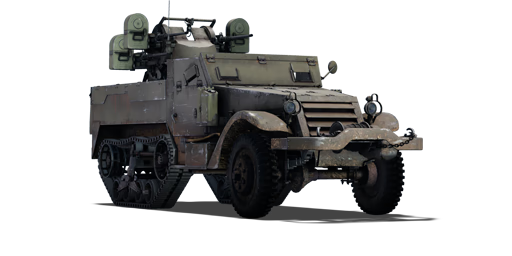



The M16 Multiple Gun Motor Carriage (MGMC) is the second variant of the M3 half-track-based self-propelled anti-aircraft gun family. It was armed with four M2HB Browning heavy machine guns mounted on an M45 Quadmount. From May 1943 to March 1944, White Motor Company produced approximately 2700 units. As aircraft became more advanced, the utility of this vehicle diminished. During the Korean War, it was primarily used for ground support and was phased out of the U.S. Army in 1954. It was nicknamed the "Meat Chopper" due to its effectiveness against enemy low-flying aircraft and infantry, making it extremely popular among soldiers.
Introduced in Update 1.45 "Steel Generals", the M16 MGMC plays similarly to the M13 MGMC. Since it is lightly armoured, it is best not to engage enemy ground units directly. Concentrate on enemy aircraft, but do not engage until the plane is close enough for direct hits. The main armament is extremely powerful, frequently igniting planes. Always reposition yourself after firing to improve your chances of survival.
| Belt | Belt filling | Armor penetration (mm) at a distance: | |||||
|---|---|---|---|---|---|---|---|
| 10 m | 100 m | 500 m | 1000 m | 1500 m | 2000 m | ||
| API-T/I/AP/API-T | 31 | 29 | 21 | 14 | 9 | 6 | |
| API-T/AP-I/API-T | 30 | 27 | 19 | 12 | 8 | 5 | |
| AP/AP/API-T | 31 | 29 | 21 | 14 | 9 | 6 | |
| API-T | 29 | 27 | 19 | 12 | 7 | 5 | |












Mobility | |
|---|---|
Protection |
|---|
Firepower | |
|---|---|